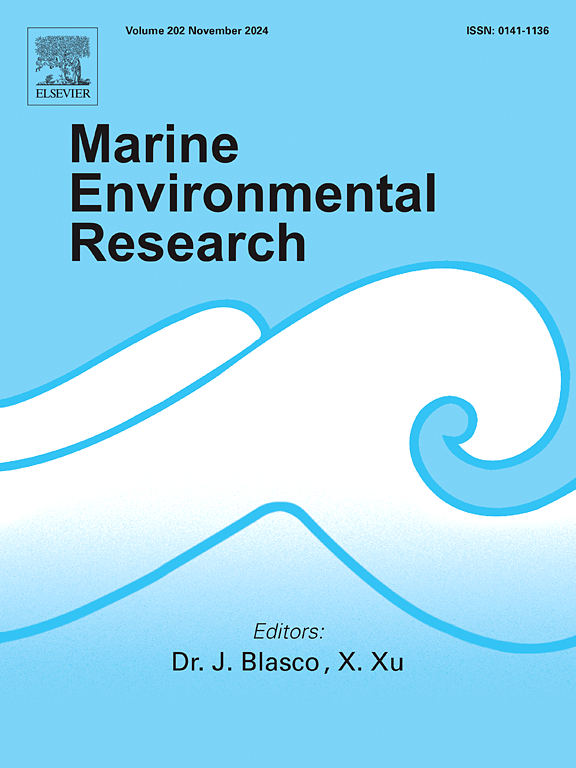营养物和溶解有机碳对北冰洋的陆地输入及其对初级生产的影响
IF 3
3区 环境科学与生态学
Q2 ENVIRONMENTAL SCIENCES
引用次数: 0
摘要
北极地区的变暖速度大约是全球平均水平的四倍,正在经历快速的气候变化,到本世纪中叶可能导致北冰洋夏季无冰。本文综述了最近关于北极生物地球化学的研究,强调了大陆径流(包括河流、永久冻土和冰川)在养分循环、碳动态和上层初级生产中的重要作用。特别是在东西伯利亚大陆架,陆地输入极大地促进了溶解有机碳(DOC)和营养物质的输出,从而影响了区域生态系统和初级生产力。海底永久冻土是DOC的主要输出源,在极端情况下,其通量估计达到700至1000 Tg / yr - 1。在北极的弱光环境中,光降解在将陆地溶解有机物(DOM)转化为营养物质方面起着至关重要的作用。值得注意的是,自20世纪90年代以来,北冰洋的浮游植物数量激增了约30%。预测表明,到本世纪末,北极净初级生产力(NPP)可能接近700 Tg C - 1,欧亚北极地区的增长比美洲和巴伦支海地区更为显著。这一趋势主要是由于陆地输入和永久冻土融化的影响。北极的研究,特别是生物地球化学和浮游植物动态响应气候变化的研究,面临着极端天气、数据稀缺和复杂环境过程的挑战。因此,持续监测和有针对性的研究,特别是在东西伯利亚大陆架和海底永久冻土区,对于克服这些挑战和提高我们对不断变化的北冰洋生态系统的理解至关重要。本文章由计算机程序翻译,如有差异,请以英文原文为准。

Terrestrial inputs of nutrients and dissolved organic carbon to the Arctic Ocean and their influence on primary production
The Arctic region, warming at approximately four times the global average, is experiencing rapid climatic shifts that could result in a summer ice-free Arctic Ocean by mid-century. This review compiles recent studies on Arctic biogeochemistry, highlighting the significant role of continental runoff—including rivers, permafrost, and glaciers—in nutrient cycling, carbon dynamics, and pelagic primary production. Particularly in the East Siberian Shelf, terrestrial inputs substantially contribute to the export of dissolved organic carbon (DOC) and nutrients, thus impacting regional ecosystems and primary productivity. Subsea permafrost emerges as a key DOC exporter, with estimated fluxes reaching 700 to 1000 Tg yr−1 under extreme scenarios. In the Arctic's low-light environment, photodegradation plays a vital role in transforming terrestrial dissolved organic matter (DOM) into nutrients. Notably, phytoplankton levels in the Arctic Ocean have surged by about 30 % since the 1990s. Projections indicate that by this century's end, the Arctic Net Primary Productivity (NPP) could approach 700 Tg C yr−1, with a more significant increase in the Eurasian Arctic than in the American and Barents Sea regions. This trend is mainly due to terrestrial inputs and permafrost thawing effects. Research in the Arctic, particularly on biogeochemistry and phytoplankton dynamics in response to climate change, faces challenges from extreme weather, data scarcity, and complex environmental processes. Therefore, continuous monitoring and targeted research, especially in the East Siberian Shelf and subsea permafrost regions, are crucial for overcoming these challenges and improving our understanding of the changing Arctic Ocean ecosystem.
求助全文
通过发布文献求助,成功后即可免费获取论文全文。
去求助
来源期刊

Marine environmental research
环境科学-毒理学
CiteScore
5.90
自引率
3.00%
发文量
217
审稿时长
46 days
期刊介绍:
Marine Environmental Research publishes original research papers on chemical, physical, and biological interactions in the oceans and coastal waters. The journal serves as a forum for new information on biology, chemistry, and toxicology and syntheses that advance understanding of marine environmental processes.
Submission of multidisciplinary studies is encouraged. Studies that utilize experimental approaches to clarify the roles of anthropogenic and natural causes of changes in marine ecosystems are especially welcome, as are those studies that represent new developments of a theoretical or conceptual aspect of marine science. All papers published in this journal are reviewed by qualified peers prior to acceptance and publication. Examples of topics considered to be appropriate for the journal include, but are not limited to, the following:
– The extent, persistence, and consequences of change and the recovery from such change in natural marine systems
– The biochemical, physiological, and ecological consequences of contaminants to marine organisms and ecosystems
– The biogeochemistry of naturally occurring and anthropogenic substances
– Models that describe and predict the above processes
– Monitoring studies, to the extent that their results provide new information on functional processes
– Methodological papers describing improved quantitative techniques for the marine sciences.
 求助内容:
求助内容: 应助结果提醒方式:
应助结果提醒方式:


